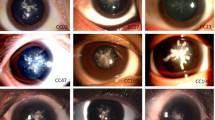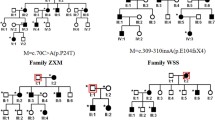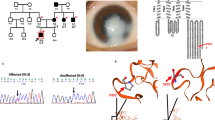Abstract
Purpose
To detect crystallin gene mutations in Turkish children with congenital cataracts.
Methods
The present study included 56 children (38 males and 18 females) who were diagnosed with congenital cataract in our ophthalmology clinic. The patients’ blood samples were collected and sent to the medical genetics laboratory. The samples were assessed using the sequence analysis method, which covered all exons of CRYAA, CRYAB, CRYBB1, CRYBB2, CRYBB3, CRYGC and CRYGD.
Results
In total, 56 patients with congenital cataracts were included in the present study. Of these, 68% were male and 32% were female. The age range of the patients was 2 months to 5 years. The mean age of onset was 21.08 ± 15.15 months. All the patients had bilateral congenital cataracts. The female-to-male ratio was 1:2.1. Mutation analysis was performed to detect possible mutations in CRYAA, CRYAB, CRYBB1, CRYBB2, CRYBB3, CRYGC and CRYGD. Of the four mutations detected, one was novel (c.383A > T in CRYGD) and three were known (c.592C > T in CRYBB2, c.164A > G in CRYGC and c.592C > T in CRYBB2). Two of these three mutations were detected in the same gene (CRYBB2). Crystallin gene mutations were detected in 7% of patients with congenital cataracts (four out of 56 patients) in the present study.
Conclusions
We think that mutations in crystallin genes are responsible for 7% of congenital cataract cases in our country. The detection of these mutations may help in the molecular diagnosis of congenital cataracts.
Similar content being viewed by others
Data availability
The authors declare that materials described in the manuscript, including all relevant raw data, will be freely available to any scientist wishing to use them for noncommercial purposes, without breaching participant confidentiality. Moreover, the authors ensure that their datasets are presented in the main manuscript.
References
Yi J, Yun J, Li ZK et al (2011) Epidemiology and molecular genetics of congenital cataracts. Int J Ophthalmol 4:422–432
Hejtmancik JF (2008) Congenital cataracts and their molecular genetics. Semin Cell Dev Biol 19:134–149
Sheeladevi S, Lawrenson JG, Fielder AR et al (2016) Global prevalence of childhood cataract: a systematic review. Eye 30:1160–1169
Messina-Baas O, Cuevas-Covarrubias SA (2017) Inherited congenital cataract: a guide to suspect the genetic etiology in the cataract genesis. Mol Syndromol 8:58–78
Scott MH, Hejtmancik JF, Wozencraft LA et al (1994) Autosomal dominant congenital cataract: interocular phenotypic variability. Ophthalmology 101:866–871
Horwitz J, Bova MF, Ding LL et al (1999) Lens alpha-crystallin: function and structure. Eye (Lond) 13(Pt 3b):403–408
Sandilands A, Hutcheson AM, Long HA et al (2002) Altered aggregation properties of mutant gamma-crystallins cause inherited cataract. EMBO J 21(22):6005–6014
Uemura Y (1971) Diagnosis of congenital cataract. Ganka 13:613–620
Richards S, Aziz N, Bale S et al (2015) Standards and guidelines for the interpretation of sequence variants: a joint consensus recommendation of the American College of Medical Genetics and Genomics and the Association for Molecular Pathology. Genet Med 17(5):405–424
Shiels A, Hejtmancik JF (2013) Genetics of human cataract. Clin Genet 84:120–127
Bharat SV, Shekhtman A, Pande J (2014) The cataract-associated V41M mutant of human γS-crystallin shows specific structural changes that directly enhance local surface hydrophobicity. Biochem Biophys Res Commun 443:110–114
Banerjee PR, Puttamadappa SS, Pande A et al (2011) Increased hydrophobicity and decreased backbone flexibility explain the lower solubility of a cataract-linked mutant of γD-crystallin. J Mol Biol 412:647–659
Devi RR, Yao W, Vijayalakshmi P et al (2008) Crystallin gene mutations in Indian families with inherited pediatric cataract. Mol Vis 14:1157–1170
Burdon KP, Wirth MG, Mackey DA et al (2004) Investigation of crystallin genes in familial cataract, and report of two disease associated mutations. Br J Ophthalmol 88:79–83
Hansen L, Mikkelsen A, Nurnberg P et al (2009) Comprehensive mutational screening in a cohort of Danish families with hereditary congenital cataract. Invest Ophthalmol Vis Sci 50:3291–3303
Kumar M, Agarwal T, Khokhar S et al (2011) Mutation screening and genotype phenotype correlation of alpha-crystallin, gamma-crystallin and GJA8 gene in congenital cataract. Mol Vis 17:693–707
Wang KJ, Wang BB, Zhang F et al (2011) Novel beta-crystallin gene mutations in Chinese families with nuclear cataracts. Arch Ophthalmol 129:337–343
Zhuang J, Cao Z, Zhu Y et al (2019) Mutation screening of crystallin genes in Chinese families with congenital cataracts. Mol Vis 25:427–437
Sun W, Xiao X, Li S et al (2011) Mutation analysis of 12 genes in Chinese families with congenital cataracts. Mol Vis 17:2197–2206
Su D, Guo Y, Li Q et al (2012) Concurrent chemoradiotherapy plus adjuvant chemotherapy versus concurrent chemoradiotherapy alone in patients with locoregionally advanced nasopharyngeal carcinoma: a phase 3 multicentre randomised controlled trial. Lancet Oncol 13:163–171
Jiaox X, Khan SY, Irum B et al (2015) Missense mutations in CRYAB are liable for recessive congenital cataracts. PLoS ONE 10:e0137973
Chen Q, Ma J, Yan M et al (2009) A novel mutation in CRYAB associated with autosomal dominant congenital nuclear cataract in a Chinese family. Mol Vis 15:1359–1365
Cui XJ, Lv FY, Li FH, Zeng K (2017) Correlations of single nucleotide polymorphisms of CRYAA and CRYAB genes with the risk and clinicopathological features of children suffering from congenital cataract. Medicine (Baltimore) 96(25):e7158
Funding
The authors did not receive support from any organization for the submitted work.
Author information
Authors and Affiliations
Contributions
All authors contributed to the study conception and design. Material preparation, data collection and analysis were performed by MK, AAD, SE, SA, ST and UK. Genetic analysis was performed by ST. The first draft of the manuscript was written by MK and all authors commented on previous versions of the manuscript. All authors read and approved the final manuscript.
Corresponding author
Ethics declarations
Conflicts of ınterest
All the authors declare that they have no conflict of interest and no financial disclosure.
Consent to participate
Informed consent was obtained from legal guardians.
Consent to publish
Additional informed consent was obtained from all legal guardians for whom identifying information is included in this article.
Ethical approval
All procedures performed in studies involving human participants were in accordance with the ethical standards of the institutional and/or national research committee and with the 1964 Helsinki Declaration and its later amendments or comparable ethical standards. The study was approved by the Ethics Committee of the Medical University of Dicle University, Diyarbakır, Turkey (decision date: 5 December 2019, No. 281).
Additional information
Publisher's Note
Springer Nature remains neutral with regard to jurisdictional claims in published maps and institutional affiliations.
Rights and permissions
About this article
Cite this article
Karahan, M., Demirtaş, A.A., Erdem, S. et al. Crystalline gene mutations in Turkish children with congenital cataracts. Int Ophthalmol 41, 2847–2852 (2021). https://doi.org/10.1007/s10792-021-01843-9
Received:
Accepted:
Published:
Issue Date:
DOI: https://doi.org/10.1007/s10792-021-01843-9




